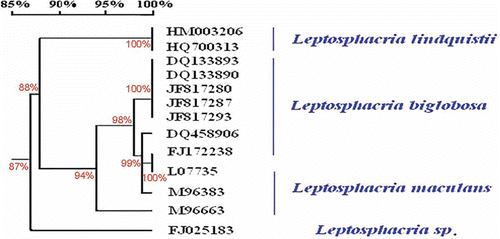Figures & data
Fig. 1. Symptoms of black stem of sunflower caused by natural infections in the field and greenhouse inoculations with Phoma macdonaldii. (a) Natural infections on stems of field-grown plants. (b) Symptoms of sunflower black stem on cotyledon petioles in field-grown plants. (c) Pycnidia formed on stems of naturally infected sunflowers in the field. (d) Chlorotic lesions on the stem surface 1–2 days after artificial inoculation. (e) Black lesions on the surface of the cotyledon petiole and stems 7 days after inoculation. (f) Development of pycnidia on oat agar culture. (g) Conidia on OA culture. Bars: a–b, e = 5 cm; d = 1 cm; f = 100 μm and g = 10 μm.


